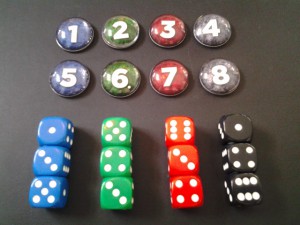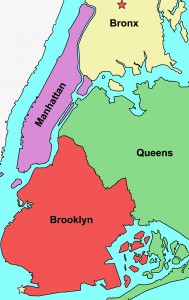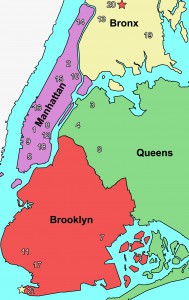
Part 1 of this post looked at nailing down the adventure idea, expanding it a bit, coming up with some pre-gen characters, and starting to flesh out the details, which is the step continuing here. Remember, if you’re just looking for the actual notes, maps, and character sheets from the game without commentary, you can download them all together here as The Warriors – Complete Package.
Step 4 – Adding Detail
By the end of Part 1, most of the pieces for this “Warriors” game existed, they just had to be put together into some workable form.
First step was to make a map for myself, to visualize New York’s five boroughs and where the major gangs’ turfs are:
The red star in the Bronx is Van Cortlandt Park, where Cyrus’s meeting takes place. The yellow star at the southern tip of Brooklyn is Coney Island, home turf of the Warriors. All the little white numbers are other gangs’ turfs in-between, keyed to this list, which shows info on the other 20 top gangs in the city. I then added to that the stat pages for Weak, Average, and Strong gangs, as well as Cops, all color-coded for streamlining combat rolls.
For example, take a look at the Average gang sheet, the one I would use for an encounter with a gang like the Punks. All needed stats for a typical member of that gang are there, as well as the leader and second-in-command. The HP of a dozen members are also given (to be easily checked off) in numerical, color-coded groups: blue (1, 5, and 9), black (2, 6, and 10), red (3, 7, and 11), and green (4, 8, and 12). Those colors correspond to sets of 3d6 and numbered glass tokens:
 Now, why bother with all that? Well, because when the PCs are fighting, say, eight Punks, you can roll all 12 of those dice together and determine whether Punks 1, 2, 3, and 4 hit with a single roll. You can then repeat for Punks 5, 6, 7, and 8 with a second roll.
Now, why bother with all that? Well, because when the PCs are fighting, say, eight Punks, you can roll all 12 of those dice together and determine whether Punks 1, 2, 3, and 4 hit with a single roll. You can then repeat for Punks 5, 6, 7, and 8 with a second roll.
The time savings of rolling twice for 8 NPCs instead of eight times can’t be overstated. For me, it’s really a game changer, letting a battle of, say, 4 Warriors against 8 Punks resolve in at least half the time, if not less. Good stuff.
With the background info down, it was time for the adventure page itself. I try hard to make a 4-hour one-shot fit on two sides of a page. I used to prefer 6-8 pages of notes, and for a lot of games still do, but even then also having the entire “flow” on a single page as bullet points means I don’t lose my place, I don’t spend more than a second or two finding anything important… it’s just all right there, and better for me.
That page shows the route both to and from Coney Island and Van Cortlandt Park, stats for Molotov cocktails (because Snow carries one), stuff to cover during the intro, and then the six “scenes” from the notecard shown in Part 1. Bam, whole game, start to finish.
Of course, this is only a kind of idealized version of things. I’m actually a very sandbox-y GM and try to let the PCs do whatever they want, since they’re the actual characters in the story. But having a solid baseline from which to deviate is enormously helpful when the players take things in their own direction.
Step 5 – Finalizing the Characters
With the adventure itself done, next step was to create the actual character sheets, turn the general notes from Step 3 into true GURPS PCs.
As always, I highly recommend the GURPS Character Assistant program (GCA) when designing characters, as it automatically keeps track of all the math and the various and sundry options. (I hear good things about GURPS Character Sheet too, but haven’t used it enough myself to comment). I’m also a huge fan of the Phoenix character sheet for GCA, which lets you really customize the final character sheet (what is shown, how it’s shown, where it’s shown).
This will drive a lot of folks crazy, but I don’t start with point totals anymore. Instead, I just stat out what I consider an “average” member of the party as a baseline, and use their point total to create the rest.
For example, I started with Swan — he’s not the strongest or the fastest, and only slightly smarter. I set his attributes where I thought made sense: ST 12 (strong, but not super strong), DX 14 (very athletic, will be good at a lot of physical skills), IQ 12 (clever and quick-thinking), HT 11 (in great shape). Then I gave him the advantages all Warriors have (Combat Reflexes, Fearlessness, Fit, High Pain Threshold, and Luck) as well as the disadvantages (Code of Honor (The Warriors), Sense of Duty (The Warriors)).
Skills are the most critical part of the character. They define the ways he can interact with the setting, things that he can do well. So I usually start with a base group of skills that all the PCs share (though at varying levels of expertise), similar to Kromm’s list from the forums, and then add in anything unique to the character. After looking over the skill list on pp. B301-304), Swan ended up with:
- Area Knowledge (New York), Navigation (Land). For getting around on foot, knowing that the PCs would begin the game stranded far from home.
- Bat, Chain, Club, Fast-Draw, Guns (Pistol), Knife. This pretty much covers the common, genre-appropriate weapons shown in the movie. Each Warrior had one skill higher than the rest (Swan’s was Knife), but at least 1 point in each so they could fight with whatever they picked up. (Vermin could use all equally, at a slightly-lower 14).
- Brawling, Wrestling. For fighting unarmed. Brawling got swapped out for Karate for Snow and Cochise, who use more kicks.
- Climbing, First Aid, Gesture, Running, Scrounging, Search, Throwing. General “adventurer”-type stuff that almost always comes up, regardless of game.
- Colors, Detect Lies, Pickpocket, Shadowing, Stealth, Streetwise. Things a gang member should know how to do.
- Diplomacy, Leadership. The social skills vary depending on the PC’s personality, with Intimidation or Fast-Talk being the most likely alternative to Diplomacy.
With all of that on the sheet, and skill levels tweaked until the character “felt” like Swan from the movie, he totaled up to something like 232 points. I rounded that a tiny bit to 250, and that became the point total for this particular game, 250 points. That may not be terribly helpful, but bear in mind this is more “how I prepped this game” than “how a new GM should prep his game.” Do what I say, not what I do?
The final characters looked like this:
I then added my “usual” stuff to fill out the characters: notes on their Code of Honor, some GURPS rules, the various Maneuvers, and a “newbie-friendly” overview of each character (what the players use as a guide when picking who to play).
Normally, I also include a simplified character sheet as a kind of bridge between the plain-English summary page and the full glory of the Phoenix sheet. I didn’t this time, and that was a mistake. The summary page isn’t quite enough (no skill levels, for one), and the Phoenix page is a bit overkill — I had more than one gamer of 20+ years’ experience have trouble finding what they needed on it because I had included everything. So, note to self for future games: a simplified character sheet is not optional.
Okay, nice! The end is in sight.
Step 6 – Final Details
All that remained from this point was a flurry of smaller items to tie everything together.
- Pictures of the Warriors not being played as PCs (Cleon, Cowboy, Fox, Rembrandt)
- Inserts for the player “name plates”
- Tri-fold paper minis for the PCs
- GM Control Sheet (courtesy of this sheet for GCA)
- PCs Hit Points
The final thing was to get the sound and music ready. This was the first game (since cassette tapes!) that I wanted to have some sound bites and background music for, because they are so iconic to the movie. Using a labyrinthine combination of Handbrake, Windows Movie Maker, and Audacity, I managed to create the following music MP3s…
- Opening Theme (the gangs on the way to the conclave)
- Fight in the Park (against the Furies, used as background combat music)
- Furies Chase (more background music)
And the following sound bites…
- Cyrus’s speech at the park (I had to have this! Condensed his entire speech from about 7 minutes to 45 seconds)
- Mercy clucking like a chicken
- Luther’s “Come out to pla-ay” (would be criminal to not use this)
- DJ, sending out the call to all the gangs to hunt the Warriors
- DJ, letting everyone know the Orphans got whupped
- DJ, letting everyone know the Furies “dropped the ball”
- DJ, her final apology to the Warriors for such a tough night, and the end theme song
With the MP3s ready, I poked around and spent a few bucks on this app called Media Soundboard for my little Asus Transformer. It isn’t perfect (see my review at that link) — it sometimes just randomly resets a soundboard you’ve already put together. Not ideal, but I realized I could backup the config file to my desktop and copy it over if that happened (which is good, since the app worked perfectly for my Friday and Saturday games, but reset the playlist when I checked 30 minutes before my Monday game; had I not backed up, we would have had no sound).
When it does work, it’s fantastic — you can play multiple files at once, set volumes individually, loop or play once, fade out instead of ending abruptly, all kinds of awesome stuff. Even with the bugginess, totally worth $2.50.
And voilà, game prep is done! All told, I’d say it took me about 20-25 Mook-hours to get everything ready, spread out over a few weeks — that’s about average (for me) for a one-shot game.
I hope you enjoyed this walkthrough of my game prep, and maybe picked up a few useful tidbits. I’d love any feedback, in the comments below or however you like!


Leave a Reply